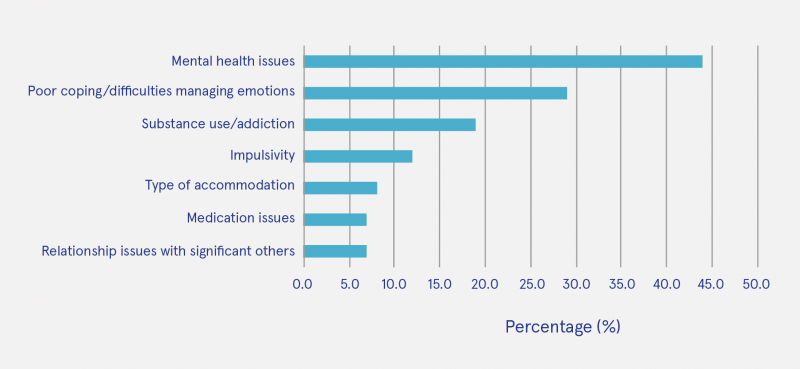Millar, Sean (2021) Self-harm in Irish prisons, 2019. Drugnet Ireland, Issue 79, Autumn 2021, pp. 37-38.
| Preview | Title | Contact |
|---|---|---|
|
PDF (Drugnet Ireland 79)
1MB |
The Self-Harm Assessment and Data Analysis (SADA) Project was set up in Ireland in 2016 to provide robust information relating to the incidence and profile of self-harm within prison settings as well as individual-specific and context-specific risk factors relating to self-harm. In addition, it examines patterns of repeat self-harm (both non-fatal and fatal). The Health Service Executive’s National Office for Suicide Prevention and the National Suicide Research Foundation assist the Irish Prison Service with data management, data analysis, and reporting. This article highlights findings from a report presenting data in the analysis of all episodes of self-harm across the Irish prison estate during the year 2019.1
Episodes of self-harm
Between 1 January and 31 December 2019, there were 203 episodes of self-harm recorded in Irish prisons, involving 109 individuals. The majority of prisoners who engaged in self-harm were male (78%), but taking into account the male prison population, the rate of self-harm among males was 2.4 per 100 prisoners. Twenty-four female prisoners engaged in self-harm in 2019, equating to a rate of 19.8 per 100 prisoners, which is 8.2 times higher than the rate among male prisoners.
Methods, severity, and intent
The most common method of self-harm recorded was self-cutting or scratching, which was present in 64.7% of all episodes. The other common method of self-harm was attempted hanging, which was involved in 21.1% of episodes. In 31% of self-harm episodes, no medical treatment was required, while almost one-half (49.8%) of all episodes required minimal intervention/minor dressings or local wound management. One in seven episodes required hospital treatment (15.3%). Over two-thirds (69%) of self-harm episodes were recorded as having no or low suicidal intent, with 22% recorded as having medium intent. Approximately one in 11 acts was rated as having high suicidal intent (8.9%).
Contributory factors
The most common contributory factors to self-harm are shown in Figure 1. The majority of contributory factors recorded related to mental health issues (44%). Substance misuse, including drug use and drug seeking, was the third most common factor recorded (19%).

Source: McTernan et al. (2021)
Figure 1: Most common contributory factors to self-harm in Irish prisons, 2019
Other findings
Other findings highlighted in the report include the following:
- Two-thirds (68%) of self-harm episodes involved prisoners in single cell accommodation. Considering the overall prison population, 51.9% of prisoners who self-harmed were accommodated in single cells in 2019.
- The rate of self-harm was higher among prisoners on remand or awaiting trial than among sentenced prisoners (5.7 vs 2.3 per 100 prisoners).
- In line with findings from previous reports, substance misuse continues to be one of the primary factors associated with self-harm among the prison population in Ireland.
1 McTernan N, Griffin E, Cully G, et al. (2021) Self-harm in Irish prisons 2019: third report from the Self-Harm Assessment and Data Analysis (SADA) Project. Longford: Irish Prison Service.
https://www.drugsandalcohol.ie/34047/
Repository Staff Only: item control page